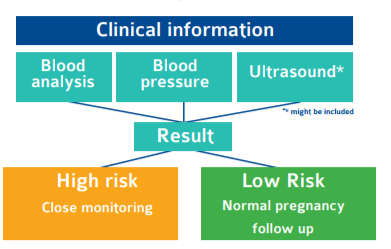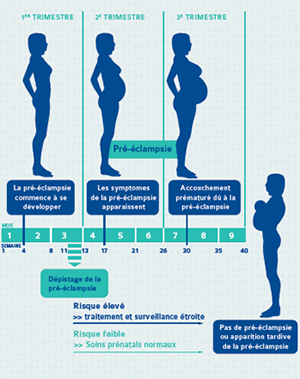it is now possible to estimate the risk to develop pre eclampsia since the 11th week of pregnancy
Most women have normal pregnancy and are in good health. However Pre-eclampsia is a relatively frequent complication which affects about 2 pregnancies out of 100 in France. Pre-eclampsia is a disease that only happens during pregnancy (any time after 20 weeks of pregnancy) and up to six weeks after delivery. It can affect you and your unborn baby. If detected soon enough, it can be monitored and controlled. The exact cause of Pre-eclampsia remains unknown but it is known that problems in terms of vascularization of the placenta contributes to its development. The placenta connects you to your baby and provides food/nutrients and oxygen from your blood. In case of Pre-eclampsia, the placenta does not receive the amount of blood that is needed and it affects you and your baby in many different ways.
 Pre-eclampsia screening can be performed in the first trimester of pregnancy, between 11th and 14th weeks. It includes a blood test, a measure of your blood pressure and a uterine doppler performed during the first trimester ultrasonographic examination.
Pre-eclampsia screening can be performed in the first trimester of pregnancy, between 11th and 14th weeks. It includes a blood test, a measure of your blood pressure and a uterine doppler performed during the first trimester ultrasonographic examination.
A result indicating a high risk does not necessarily mean that you will develop a Pre-eclampsia. If your result indicates a risk higher than the normal, your doctor can anticipate a close monitoring of your pregnancy to prevent you from further complications. The result of the screening test helps you, as well as healthcare professionals, to be attentive to possible signs and symptoms of Preeclampsia.
A result indicating a low risk means that you are unlikely to develop Pre-eclampsia during your pregnancy. Presenting a low risk does not fully eliminate the risk of Pre-eclampsia. You will continue to benefit from normal prenatal care.
 You may know your risk of developing Pre-eclampsia between 11 and 14 weeks of pregnancy.
You may know your risk of developing Pre-eclampsia between 11 and 14 weeks of pregnancy.
The test can be performed at the same time and on the same sample as the Down syndrome sera markers.
At the threshold of 1/20, the patient will be placed in a group at increased risk of developing pre-eclampsia either early (before 34WA) or late (after 34WA). This estimation of the risk makes it possible to orient the patient towards a circuit of adapted care.